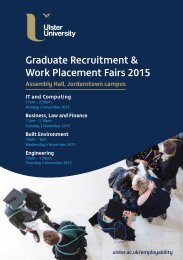Public Attitudes to Peace Walls (2015)
1RRkqqy
1RRkqqy
Create successful ePaper yourself
Turn your PDF publications into a flip-book with our unique Google optimized e-Paper software.
<strong>Public</strong> <strong>Attitudes</strong> <strong>to</strong> <strong>Peace</strong> <strong>Walls</strong> (<strong>2015</strong>)<br />
Survey Results<br />
Ulster University<br />
‘constant problems’ that might result from the walls being removed. Indeed, 17% of respondents<br />
living closest <strong>to</strong> the walls said that they would try <strong>to</strong> move away if the walls in their areas were <strong>to</strong><br />
come down. Greater use of CCTV and a stronger police presence were viewed by respondents as<br />
the most appropriate response <strong>to</strong> any change in the conflict architecture where they lived.<br />
The removal of the peace walls has been widely unders<strong>to</strong>od as the ultimate symbolic act of<br />
reconciliation between two communities who have traditionally prioritised separation over<br />
sharing. But perhaps the most uncomfortable result of the 2012 survey was that 69% of<br />
those living closest <strong>to</strong> the walls believed that the walls must remain (for now) because of the<br />
potential for violence (Gormley-Heenan et al, 2013). Almost two decades after the paramilitary<br />
ceasefires, walls were still seen as a necessary protection from violence emanating from ‘the other’<br />
community.<br />
The purpose of this new survey, conducted in mid-<strong>2015</strong>, has been <strong>to</strong> ascertain and understand<br />
whether public attitudes <strong>to</strong> the removal of peace walls had changed in any way over the last 3<br />
years.<br />
Since the last survey, much has happened in the political and policy arenas. Extensive loyalist<br />
protests against the December 2012 decision of Belfast City Council <strong>to</strong> fly the Union flag from<br />
Belfast City Hall on designated days and the continuing dispute over parading at Ardoyne/<br />
Twaddell since July 2013 led <strong>to</strong> a measurable hardening of attitudes <strong>to</strong>wards reconciliation and<br />
cross-community relationships on all sides, but particularly within loyalist communities.<br />
In addition, interface areas remain characterised by social deprivation, which has almost certainly<br />
deepened in the difficult economic climate since 2008. The desire for change in interface areas<br />
whether through plans <strong>to</strong> remove peace walls or <strong>to</strong> reimage interface areas through public<br />
investment has not been matched by the scale of public funding available <strong>to</strong> actualise the<br />
changes needed.<br />
Against this political and economic backdrop, government policy also changed. Among the<br />
various targets and objectives identified within the Together: Building a United Community<br />
(TBUC) strategy, was the target of removing ALL interface barriers (peace walls) by 2023. The key<br />
principles underpinning this intervention were that: local communities should come <strong>to</strong>gether <strong>to</strong><br />
produce a phased plan of how <strong>to</strong> reduce and eventually remove the barrier; maximum consensus<br />
should be achieved from both sides of the wall/barrier; personal and property safety are core<br />
issues and considerations for the plan; and departments and agencies would need <strong>to</strong> give priority<br />
<strong>to</strong> consideration of plans. Community engagement in the process was regarded by the Executive<br />
as critical: ‘Taking down interface barriers is not something that can be achieved without<br />
engagement with, consent and support of the people who live there. We must be sensitive <strong>to</strong> the<br />
views and perceptions of residents and balance this against the responsibility on us <strong>to</strong> create the<br />
conditions within which division and segregation can become resigned <strong>to</strong> the past’ (TBUC, 2013).<br />
It is in this political, economic and policy context that the results of the <strong>2015</strong> attitudinal survey on<br />
peace walls must be considered.<br />
4




